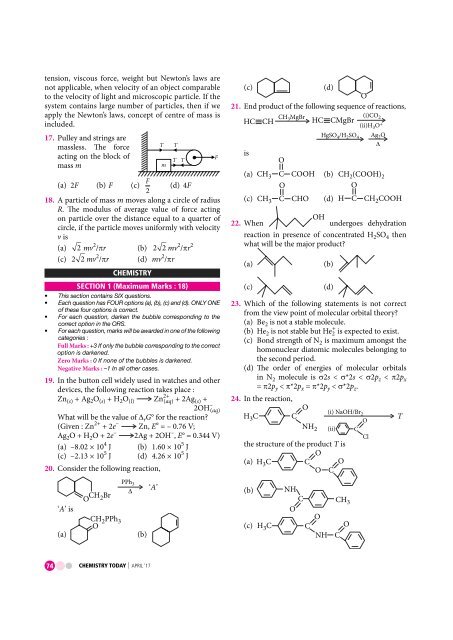Chemistry_Today_April_2017_vk_com_stopthepress
You also want an ePaper? Increase the reach of your titles
YUMPU automatically turns print PDFs into web optimized ePapers that Google loves.
tension, viscous force, weight but Newton’s laws are<br />
not applicable, when velocity of an object <strong>com</strong>parable<br />
to the velocity of light and microscopic particle. If the<br />
system contains large number of particles, then if we<br />
apply the Newton’s laws, concept of centre of mass is<br />
included.<br />
17. Pulley and strings are<br />
massless. The force<br />
T T<br />
acting on the block of<br />
T T<br />
F<br />
mass m<br />
m<br />
F<br />
(a) 2F (b) F (c) (d) 4F<br />
2<br />
18. A particle of mass m moves along a circle of radius<br />
R. The modulus of average value of force acting<br />
on particle over the distance equal to a quarter of<br />
circle, if the particle moves uniformly with velocity<br />
v is<br />
(a) 2 mv 2 /r (b) 2 2mv 2 /r 2<br />
(c) 2 2mv 2 /r (d) mv 2 /r<br />
CHEMISTRY<br />
SECTION 1 (Maximum Marks : 18)<br />
• This section contains SI questions.<br />
• Each question has FOUR options (a), (b), (c) and (d). ONLY ONE<br />
of these four options is correct.<br />
• For each question, darken the bubble corresponding to the<br />
correct option in the ORS.<br />
• For each question, marks will be awarded in one of the following<br />
categories :<br />
Full Marks : +3 If only the bubble corresponding to the correct<br />
option is darkened.<br />
Zero Marks : 0 If none of the bubbles is darkened.<br />
Negative Marks : –1 In all other cases.<br />
19. In the button cell widely used in watches and other<br />
devices, the following reaction takes place :<br />
Zn (s) + Ag 2 O (s) + H 2 O (l) Zn 2+<br />
(aq) + 2Ag (s) +<br />
2OH – (aq)<br />
What will be the value of D r G° for the reaction?<br />
(Given : Zn 2+ + 2e – Zn, E° = – 0.76 V;<br />
Ag 2 O + H 2 O + 2e – 2Ag + 2OH – , E° = 0.344 V)<br />
(a) –8.02 × 10 4 J (b) 1.60 × 10 5 J<br />
(c) –2.13 × 10 5 J (d) 4.26 × 10 5 J<br />
20. Consider the following reaction,<br />
(c)<br />
(d)<br />
O<br />
21. End product of the following sequence of reactions,<br />
HC CH<br />
(i)CO 2<br />
(ii)H 3 O+<br />
HgSO 4/H2SO4 Ag 2 O<br />
<br />
CH MgBr 3<br />
HC CMgBr<br />
is<br />
(a) CH3<br />
O<br />
C COOH<br />
O<br />
(c) CH3<br />
C CHO<br />
(b) CH 2 (COOH) 2<br />
O<br />
(d) H C CHCOOH 2<br />
OH<br />
22. When<br />
undergoes dehydration<br />
reaction in presence of concentrated H 2 SO 4 then<br />
what will be the major product?<br />
(a)<br />
(c)<br />
(b)<br />
(d)<br />
23. Which of the following statements is not correct<br />
from the view point of molecular orbital theory?<br />
(a) Be 2 is not a stable molecule.<br />
(b) He 2 is not stable but He + 2 is expected to exist.<br />
(c) Bond strength of N 2 is maximum amongst the<br />
homonuclear diatomic molecules belonging to<br />
the second period.<br />
(d) The order of energies of molecular orbitals<br />
in N 2 molecule is 2s < *2s < 2p z < 2p x<br />
= 2p y < *2p x = *2p y < *2p z .<br />
24. In the reaction,<br />
HC 3 C<br />
O<br />
(i) NaOH/Br 2<br />
O<br />
NH 2 (ii) C<br />
Cl<br />
the structure of the product T is<br />
O<br />
(a) HC 3 C O<br />
O C<br />
T<br />
‘A’ is<br />
(a)<br />
CH Br 2 O<br />
CH PPh 2 3<br />
O<br />
PPh 3<br />
<br />
(b)<br />
‘ A’<br />
(b)<br />
NH<br />
C<br />
O<br />
(c) HC 3 C<br />
CH 3<br />
O<br />
O<br />
NH C<br />
74 CHEMISTRY TODAY | APRIL ‘17


